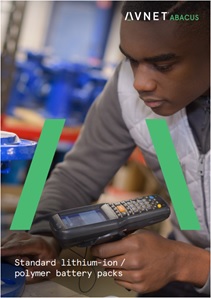Strategies to combat volatility in the lithium-ion battery market

Rapidly increasing market demand and the rationalisation of product offerings from Li-ion cell manufacturers are impacting the choices available to design engineers. Here Tim Parker discusses the background to these dynamics and how engineers can successfully navigate this challenging market.
We’ve all heard of the considerable increase in demand for lithium-ion batteries driven by their increasing inclusion in portable devices and electric vehicles. Since the first batteries were commercialised by Sony in 1991 their use initially steadily increased and then levelled, but recently Tesla has led a surge in demand (see figure 1) with 18650 size cylindrical cells in its existing electric vehicles and now the larger 21700 size in the new model 3, all manufactured in partnership with Panasonic. Tesla’s target for 2018 is to reach a production of 35GWh, but may ultimately be dwarfed by the VW automobile group with its plans to install 150GWh-worth of batteries each year from 2025 in 80 new electric models.
Portable devices and other applications such as mobility, grid storage and stationary equipment are not being left behind though, with their share of the Li-ion pack market actually predicted to be about twice that of all EVs in 2025 at about $24B [1]. Other reports are more bullish and put the total Li-ion market even bigger at $93.1B by 2025 [2]
Currently raw material supply is not meeting projected demand and extra capacity is planned for lithium extraction with major expansion in China, Canada, Australia, South America and elsewhere. Other exotic materials are required as well; cobalt is used as a cathode material with China controlling 80% of that market. From data compiled by Deutsche Bank Markets Research [3], global lithium demand is set to increase three times between 2015 and 2025, cobalt eleven times and overall battery consumption five times.

Figure 1. Lithium battery usage. Source - Avnet Abacus, estimated
The major manufacturers of Li-ion cells are juggling the competing forces of demand and raw material supply and are standardising on cell size and construction to get economies of scale. Many existing designs of the ‘prismatic’ style in welded aluminium or steel housings are being discontinued in favour of ‘pouch’ cells, often in lithium-polymer technology that allows a laminated construction, which is lighter and gives mechanical flexibility and slightly higher specific energy. Pouch cells do suffer from swelling with charge/discharge cycling though, with smaller sizes growing as much as 10% in volume over 500 cycles. The standard 18mm x 65mm 18650 cylindrical cells and larger variants will certainly still be supported for some time to come, as the format suits applications like Tesla’s 100kWhr module where 8256 cells are stacked in staggered rows with pipes for liquid cooling. The cylindrical wound format is good for mechanical stress resilience and the small remaining gaps between cells allow for some air-cooling. The volume of cylindrical cells produced over the years has also brought their cost down considerably.

Figure 2. Selection of Li-ion batteries from Avnet Abacus
So, as a design engineer, you’ve decided on a Li-ion battery for your new device and need a few prototypes. The prospective production volume is, you hope, high but getting one of the ‘big four’ manufacturers to consider supporting a new custom design is a mountain to climb. A solution is to pick from the extensive range of standard parts from Avnet Abacus, [4] which includes the 18650 size cylindrical cells from major suppliers Dubilier, Panasonic, RRC, Samsung and Varta, available in single 3.7V cells from 2250mAh to 3300 mAh, to packs of up to 70 cells at 25.2V/29000mAh. A range of ‘prismatic’ types are supported in single and 3-cell formats along with a more extensive range of ‘pouch’ lithium polymer cells in varying mechanical sizes and ratings from 130mAh to 3000mAhr. Many of the prismatic ‘hard pack’ variants are supported by relevant chargers. The standard range also features the Coin Power Li-ion button cells from Varta.
 |
A suitable Li-ion battery type for most applications is available from the Avnet Abacus range [4] with a variety of construction styles, dimensions and capacities. ‘Soft’ packs suit embedded applications and ‘hard’ packs are ideal for ease of removal, recharging and replacement with some types even including SMBUS SMART functionality. The parts are available on very short lead-times with low MOQs giving fast time to market. As you would expect from the world-class suppliers represented, all battery packs meet the minimum approvals for shipping of lithium-ion and polymer products. All lithium batteries meet the UN regulation (UN38.3) for worldwide transportation by air, road and sea freight. Many of the parts also meet IEC62133/CB scheme and UL2054 safety standards for regional and US markets. Continuity of supply is offered in many of the products with a guaranteed product availability of 10-15 years. For more information visit batteries page or download the Avnet Abacus standard lithium-ion battery brochure here. If you need advice on battery selection for your application, click the Ask an Expert button to get in touch with one of our technical specialists in your local language. |
References
[1] AVICIENNE ENERGY worldwide rechargeable battery marketing 2016-2025
[2] https://www.grandviewresearch.com/press-release/global-lithium-ion-battery-market
[3] https://www.prnewswire.com/news-releases/emergence-of-electric-vehicles-to-push-demand-for-lithium-and-cobalt-674165683.html
[4] Avnet Abacus Lithium-ion Battery Brochure

Ask an expert
Have a question? Our regional technical specialists are on hand to help.




